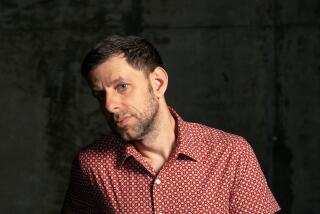WAGNER AT THE MET : A ‘MEISTERSINGER’ THAT IS MIRED IN ROUTINE
- Share via
NEW YORK — Wagner’s “Die Meistersinger von Nuernberg” evolves and revolves around the complex character of Hans Sachs.
He must be warm and wise. He must be old enough to have seen it all, young enough to still want to see more, practical enough to be a cobbler, idealistic enough to be a poet.
He must command a vibrant, wide-ranging bass-baritone voice. It must be sufficiently dramatic to dominate an overpopulated stage and a massive orchestra with the power of a Wotan, yet sufficiently lyrical to probe the introspective passages with the grace of a lied specialist.
The current revival of “Die Meistersinger” at the Metropolitan Opera doesn’t have a Hans Sachs.
It only has Franz Ferdinand Nentwig, who strikes amiable poses, approximates the vocal line with thick, dark, coarse, often off-pitch mutterings, and runs out of voice long before the 5 1/2-hour marathon reaches its bombastic, Deutschland-ueber-Alles climax on the festival meadow.
One cannot blame the failure entirely on Nentwig, essentially a conscientious and competent singer. One must blame the Met management, which once again seems guilty of either wishful thinking or, much worse, cynical miscasting.
Even with a bona-fide Sachs, however, this “Meistersinger” would do little credit to one of the world’s great opera houses.
Christof Perick, who made his debut replacing the originally scheduled James Levine in the pit, conducts with ample brio but generalized sentiment. Tuesday night, he also seemed to be laboring under the disadvantage of inadequate rehearsal.
The production itself, now 22 years old, is a compendium of hoary cliches. Nathaniel Merrill, the original director, was seldom more than a traffic cop, and not a very effective one in the crowd scenes. Bruce Donnell, who has inherited the blocking, adds a few obtrusive comic touches but no interpretive insights.
Robert O’Hearn, the stolid designer, created an ultra-realistic church for Act I, a reasonably credible medieval street for Act II, a homey study for Sachs in Act III and the clashing contradiction of a stark, stylized Nuremburg for the festive finale.
Ironically, the most interesting person on the stage is a man who wasn’t supposed to be there. Original plans called for Edward Sooter, a reliable and routine Wagnerian, to portray the heroic Walther von Stolzing. Without explanation, however, the Met substituted Peter Hofmann, a German supertenor who isn’t even listed on this year’s roster.
His demeanor may be a bit casual for a 16th-Century Franconian knight, but he looks like a blond Adonis and often sings like one. Contrary to some predictions, he mastered the long, high role with ardor and point, and even sounded fresh at the end of the Prize Song. When in form like this, he can have few serious rivals.
Mari Anne Haeggander provided the complement of a young, pretty and spunky Eva whose pure, lustrous tones tended to turn edgy under pressure.
Otherwise, the only performance of distinction came from Matthias Hoelle--like Haeggander, an import from Bayreuth--whose mighty black basso boomed the proclamations of the night watchman.
Dieter Weller offered a fussy Beckmesser unencumbered with caricature but incapable of much musical or theatrical illumination. Gwynne Howell introduced a bland Pogner, Diane Kesling a pallid Lene, Richard J. Clark a rough, overdrawn Kothner.
Most disturbing, perhaps, was David Rendall, who brought a nice, if tough, Mozartean tenor to the music of the young apprentice David but compromised any vocal advantage by conveying the image of a mature, rotund bully.
“Die Meistersinger” is one of the loftiest challenges in the operatic catalogue. The opera demands, and often brings out, the best in a company. The Met cranked it out as if it were just another “La Boheme.”
More to Read
The biggest entertainment stories
Get our big stories about Hollywood, film, television, music, arts, culture and more right in your inbox as soon as they publish.
You may occasionally receive promotional content from the Los Angeles Times.










